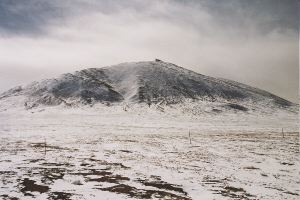 In the early afternoon, the
sky clouded over with grey stratus cloud for an hour or so.
In the early afternoon, the
sky clouded over with grey stratus cloud for an hour or so.
SoftDawn |
Train Across Tibet |
Lanzhou |
Plateau 1 |
Plateau 2 |
Plateau 3 |
Lhasa
 In the early afternoon, the
sky clouded over with grey stratus cloud for an hour or so.
In the early afternoon, the
sky clouded over with grey stratus cloud for an hour or so.
It was easy to see that herding of livestock is an important part of Tibet's economy. Herds
of yaks and sheep were observed from the train.
Herds were tended by a shepherd - there were no fences apart from herding yards. Many herds
seemed to be at a distance from towns and buildings. Even in the good weather we experienced, it
would get very cold at night. On the other hand, substantial semi-permanent tents and huts were
observed with motor bikes and trucks parked outside.
In Lhasa in the Tibetan quarter there are open-air butcher shops selling meat to the locals and
where the massive ribcages of the yak can be seen waiting for processing. There are also stalls
and shops selling piles of yak butter.
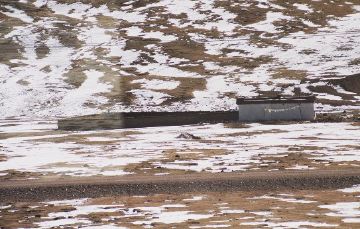 A good day to dry the washing!
A good day to dry the washing!
An isolated dwelling with a herding yard. Is this a summer dwelling, or one for
all-year-round living? Is it a seasonal base for a semi-nomadic family?
One of a small number of such (semi-permanent?) bases observed.
Do the inhabitants live here in summer to move their animals around on good pasture? A
semi-nomadic way of life? Would need to abandon these bases and return to a town in winter.
Stock would need to be taken back to quarters protecting against the harsh conditions of winter.
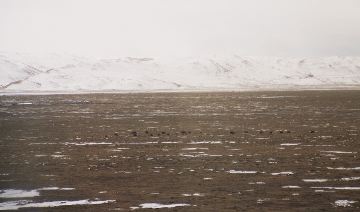 Another herd of yaks on a flat plain with buildings in the distance (on the left).
Another herd of yaks on a flat plain with buildings in the distance (on the left).
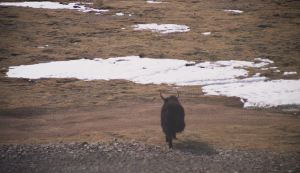 A nonchalant yak ignores the passage of the train.
A nonchalant yak ignores the passage of the train.
The speed of the train was not high at any stage and was not of an order to frighten nearby
animals, or birds perched on adjoining electricity poles.
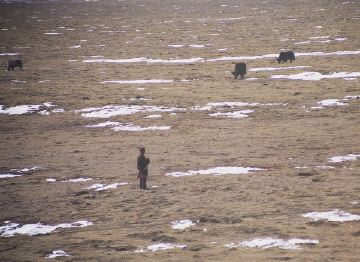 A herder in traditional clothing minding his animals.
A herder in traditional clothing minding his animals.
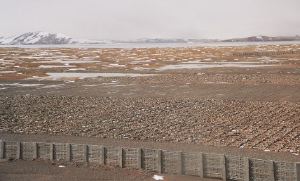 Environmental works beside the railway and a fence (on the right) towards the lake. The lake in
the distance is part of the lake in the next photo.
Environmental works beside the railway and a fence (on the right) towards the lake. The lake in
the distance is part of the lake in the next photo.
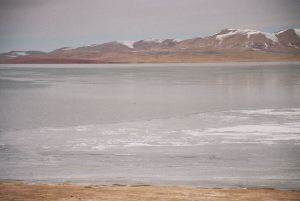 A large lake with floating ice near Cuo Na Hu.
A large lake with floating ice near Cuo Na Hu.
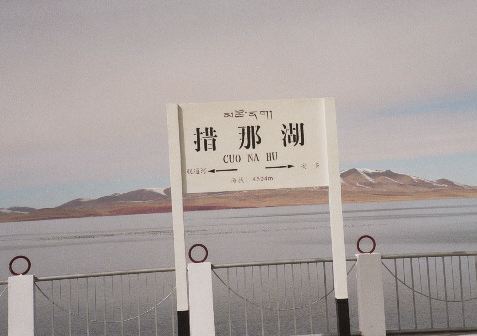 The railway station of Cuo Na Hu (altitude 4595 m) with the large lake in the background.
We stopped at this station to allow a train going in the opposite direction to pass.
The railway station of Cuo Na Hu (altitude 4595 m) with the large lake in the background.
We stopped at this station to allow a train going in the opposite direction to pass.
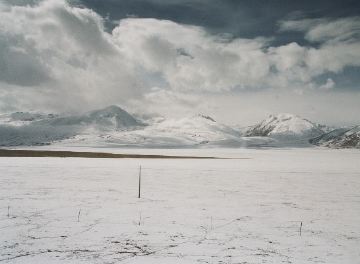 A snow covered area with the indistinct outline of the road in the snow.
A snow covered area with the indistinct outline of the road in the snow.
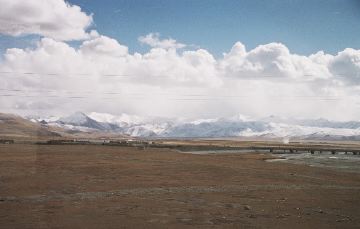 The plume in the middle right is thought to be from a geothermal plant. It seems Tibet has a
large number of geothermal springs.
The plume in the middle right is thought to be from a geothermal plant. It seems Tibet has a
large number of geothermal springs.
Looking back from the train, the elevated track can be seen passing by a small town and hugging
the contours of the valley floor.
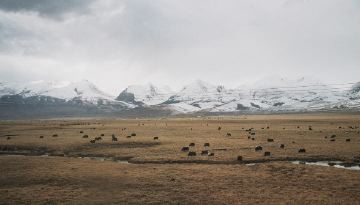 A large herd of yaks on swampy ground.
A large herd of yaks on swampy ground.
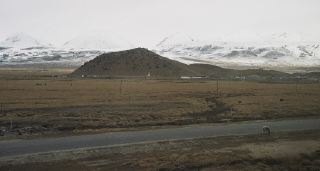 A town beneath a isolated hill and a nonchalant sheep beside the road.
A town beneath a isolated hill and a nonchalant sheep beside the road.
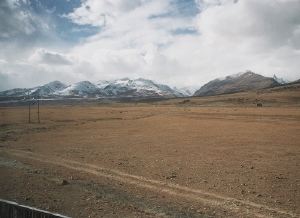 About an hour out of Lhasa we went through a long down-hill tunnel.
About an hour out of Lhasa we went through a long down-hill tunnel.
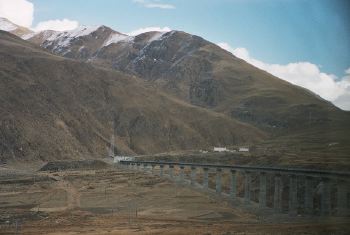 As we approached Lhasa the mountains became much larger towering above the valley floors.
As we approached Lhasa the mountains became much larger towering above the valley floors.
We hope these photographs and comments give you an insight into the Tibetan Plateau and the life it supports. Go on and see our Lhasa page.
From this day-long train journey across the Tibetan Plateau it was possible to make tentative observations about the environmental impact of the railway and the possible impact of global warming on the railway. Also out stay in Lhasa fostered thoughts about the railways effect on the Tibetan way of life. These observations are explored on a separate page.
Reportage of the day-long train journey across the Tibetan Plateau has been broken into 3 pages to make it more digestible. You can reach Plateau 1 and Plateau 2 by clicking on these links, or on the tags at the top, or bottom, of this page.
SoftDawn |
Train Across Tibet |
Lanzhou |
Plateau 1 |
Plateau 2 |
Plateau 3 |
Lhasa